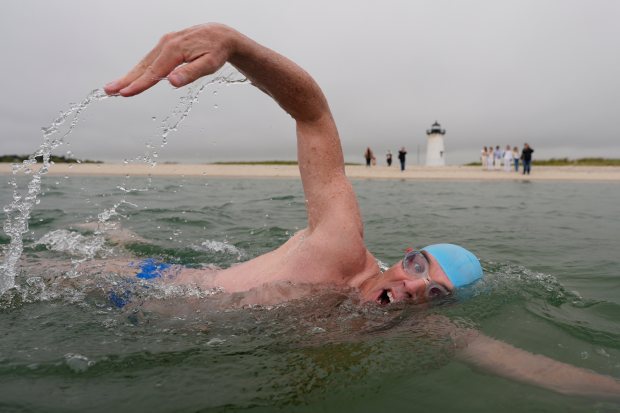Few things in my life have been as consistent as “Jaws.”
I have no friendships as old as my relationship with “Jaws.” It debuted 50 years ago this spring, soon after Memorial Day, and for those of us who spent summer breaks getting wrinkled in water, it ruined the next eight weeks. It was the first movie I saw in a theater (or in my case, a drive-in). Having grown up and regularly vacationed not that far from where it was shot, whenever I catch a snippet of “Jaws” on TV, even decades later, I am partly watching a film and partly seeing family photos, a childhood and home movies from New England beaches, circa 1974.
Boardwalk arcade games.
Unleashed dogs.
Suntan oil, not sunblock.
Sublime lethargy, soundtracked in one scene by a beach radio that’s faintly wafting Olivia Newton-John’s “I Honestly Love You” — although, trivia alert, in the film, it’s a cover by Lynn “Rose Garden” Anderson, as well as a devilish example of a 28-year-old Steven Spielberg’s genius for detail. Just as you hear it, the song is cued to: “I’m not trying to make you feel uncomfortable.”
“Jaws,” for me, remains uncomfortable and bittersweet, hilarious and rousing, and though Roy Scheider’s sons in the film supposedly have New York accents, they sound much more working-class New England and when I hear them, I always get homesick. I catch glimpses of free-range summer vacations — one of those sons takes a dingy into a pond, without supervision — and mentally note coastal buildings and roads and landscapes irrevocably altered or no longer there. “Jaws,” for me, is more of a documentary. Every election cycle, I smile when someone posts a photo of the actor Murray Hamilton with a reminder: The mayor in “Jaws” is still mayor in “Jaws 2.”
That said, from Cape Cod to saltwater-free Chicago, perhaps for you, the response was just as primal: “Jaws” inaugurated the lifelong feeling that something’s down there, beneath us in the water, wherever we were swimming, even if we were wading in a neighbor’s aboveground pool.
My daughter once eye-rolled me, suspicious at my claim that “Jaws” kept people out of the water for years, regardless of whether that body of water was the Atlantic Ocean, Lake Michigan or a backyard swimming pool. I assured her, there’s good reason Universal Pictures decided the tagline for “Jaws 2” needed to be: “Just when you thought it was safe to go back in the water …” There’s even a clinical name for the phobia that “Jaws” appeared to exacerbate among a population who probably didn’t know they had it to begin with: Thalassophobia, or the intense foreboding one feels around deep water and whatever exists under the surface.
Ask a film critic and they will confirm, regardless of whether they agree: “Jaws” gets routinely name-checked as one of the few perfect movies in the entire history of cinema, a movie so much about its own medium that in 1975 Pauline Kael wrote of running into a veteran director who was astonished by the young upstart director of “Jaws.” The filmmaker said that Spielberg “must never have seen a play. He’s the first one of us who doesn’t think in terms of the proscenium arch. … There’s nothing but the camera lens.”
Here’s how that translated inside a theater: Audiences floated at the lip of the ocean, the waves casually slapping at the bottom of movie screens, reminding them, without spelling it out, that something’s below. Here’s how it translated after we left the theater: A horror flick irrevocably changed our relationship to swimming. Hitchcock’s “Psycho” spoiled the long hot shower for a few years, but Spielberg ruined 70% of the Earth’s surface.
A few weeks after “Jaws” opened, a columnist at this newspaper, taking this temperature of alarm, reminded readers they had a better chance of being struck by lightning than being eaten by sharks. Besides, the (true-ish) story Quint tells in the film about the hundreds of soldiers killed by sharks after the U.S.S. Indianapolis sank — an exaggeration. It wasn’t hundreds, it was “70 or 80 at most.” Whew. A few months after “Jaws” opened, the fear remained so real that another columnist noted: “The silver screen knoweth no salt-water boundaries. Somewhere in the country, a swimmer may well be looking for a fin in his chlorinated pool at this very moment.” Grabbing the feet of fellow swimmers was now a thing. By summer’s end, humming “DunDunDunDUNDUN” was already a cliche.
Asked by a reporter that summer if “Jaws” had already become indelible, Roy Scheider could not have answered more wrongly: “Traumatic shocks in entertainment disappear.”
Sorry, Chief Brody, but for years afterward, reporters and editors at this paper received the occasional letter or phone call, from tourists testing Oak Street Beach, from visiting suburbanites, seeking reassurance, or just wondering: Could Lake Michigan contain a shark or two? Philip Willink, a researcher for the Illinois Natural History Survey, former senior biologist at Shedd Aquarium and co-author of the new “Fishes of the Chicago Region: A Field Guide,” remembers the movie creating “all kinds of problems for regional fish biologists. I used to routinely get calls from concerned parents wondering if it was safe to let their kids swim at Chicago beaches — or was there a risk of shark attack.”
There was not.
Still, the other day I spotted a bumper sticker: “The Great Lakes: Unsalted and Shark Free.” As Henry David Thoreau once wrote presciently: “I have no doubt that one shark in a dozen years is enough to keep the reputation of a beach a hundred miles long.”

Rumors are pesky creatures: The big one that got going after “Jaws” was an urban legend about a boy named George Lawson who, depending on who told it, lost a leg to a shark in Lake Michigan or was eaten and never found. This did not happen. But what did was at least one hoax, as well as an incident biologists still debate. The hoax: In spring 1969, two fishermen pulled up a dead 29-inch-long shark off Milwaukee. After their catch created a bout of agita along Lake Michigan, a Wisconsin tavern owner admitted he had snagged a shark off Florida in 1967, and, for reasons lost to history, kept it in a refrigerator, presumably biding time until his killer prank. As recently as 2008, a dead two-foot-long blacktip shark was found near Traverse City, Michigan — again, it was probably imported and then dumped, or so says the Michigan Department of Natural Resources.
Less clear-cut is what happened in 1937 on the Mississippi River in Alton, Illinois: Though sharks are largely a saltwater species, fishermen working along the Missouri line pulled up a five-foot-long bull shark. Photographic evidence points to a bull; researchers at the time confirmed, yes, it’s a bull. But just last year, a piece in the Detroit Free-Press described biologists as still split on whether that catch was just another hoax or, more likely, a terrific example of the adaptability of the bull shark.
Look, don’t listen to me, try a professional fish man: Kevin Feldheim of the Field Museum, whose work focuses on the biology of sharks, said: “Some sharks — bulls in particular — can tolerate fresh water and do swim quite far up rivers.” Bulls are special. But he’s never heard of a bull navigating fresh water as far north as a Great Lake. However, as a child in the Los Angeles suburbs, he did get interested in sharks because of “Jaws.” It never affected whether or not he swam in pools.
“Although the movie ‘Piranha’ did.”
Considering that 1978’s “Piranha” — directed by a young Joe Dante and written by a young John Sayles — was one of the first successful “Jaws” rip-offs, I believe this is splitting hairs. Irrational fear is not different from the panic sweeping beaches in “Jaws.”
There’s truth involved: When I was a kid, a friend whose home stood on stilts alongside a cove on Rhode Island’s Narragansett Bay — which does see the occasional great white shark — was convinced a great white ate his dog. In truth, it was likely a mako.
Whew, again.
But also, there’s more perception than reality. Another friend of mine, an NCAA swimmer back in college, often finds herself in a freshwater lake in New York: “When I am doing a long swim across the lake, I often think of the (“Jaws”) poster and get myself all anxious.” Brian Samuels, a Deerfield native and fishmonger at Dirk’s Fish in Lincoln Park, informed me: “I would not swim in public pools because of (‘Jaws’). Not just that, but across the street from my house, a neighbor had a pool. I was convinced beneath me in that dark water was a shark, because, of course, there had to be.”
Even Gene Pokorny, principal tubaist for the Chicago Symphony Orchestra — who has played the infamously ominous tuba thumps in the “Jaws” score at Ravinia Festival while conducted by John Williams, its Oscar-winning composer — does not swim in deep bodies of water, period. He always thinks of “the guys from the U.S.S. Indianapolis.” He also thinks of Tommy Johnson, his late friend and teacher, who played the tuba on the “Jaws” soundtrack. In fact, Pokorny was there at the recording:
“I remember it clearly and I remember the circumstances were horrendous. I was there with three friends from the University of Southern California and we had managed to get permission to watch. I was in my last quarter of college at the time. We didn’t really know anything about the film itself, but I remember (the recording session) was late in starting because Tommy, my tuba teacher, was also a regular instructor at a high school and it was rainy that day and the substitute who was coming to fill in for him was late. Plus, there’s the traffic in LA. So everyone is already there waiting when Tommy comes crashing in. The whole orchestra is waiting. Tommy makes his way toward the back row and John Williams just goes, ‘ARE you ready?’ Tommy says ‘Sure,’ pulls out the music, looks at it, the red light goes on to record. He did it cold. There was a movie screen in the studio set to that first scene in the movie, with the woman swimming at night in the ocean. Tommy did not even have the right tuba that day, but the double bassists came in and he nailed it perfectly. It’s what you hear in the movie, one of the most remarkable things. He played tuba on tens of thousands of film and TV scores, but this became his claim to fame. I remember thinking how the images on screen were perfectly complemented by this music. I remember watching with my mouth wide open.”

I can think of no better illustration of the power “Jaws” that retains: Pokorny was present while its Hollywood mythology was being crafted, and he still can not swim in an ocean.
As biologists have noted over the past 50 years, sharks ironically became the true victims of “Jaws,” villainized and exploited by industries that lobbed off fins for food. The upside is that sharks also became symbols of ocean conservation — a cause that “Jaws” author Peter Benchley espoused during the last years of his life, before he died in 2006.
In case you’re wondering, the Florida-based International Shark Attack File says that, since 1975, less than 60 people have been killed by great white sharks, worldwide. Not one of those people was swimming in Lake Michigan. According to the Coast Guard’s Great Lakes offices in Cleveland, shark sightings across the Midwest are now basically zilch.
Still, Willink, of the Illinois Natural History Survey, said he was vacationing last year on the South Carolina coast when he noticed a fin slice the ocean surface, not far from his son. They had recently watched the film for the first time, and though his son showed no fear of swimming in oceans, Willink’s heart jumped into his throat. The scene in which a mother “is wandering hopelessly and in grief along the surf is seared in my memory.”
That fin belonged to a bottlenose dolphin.
“But my first thought was the movie ‘Jaws.’”
cborrelli@chicagotribune.com
The Music Box hosts a 50th anniversary screening of “Jaws” in 35mm at 9 p.m. May 26; musicboxtheatre.com. The Alamo Drafthouse Cinema in Wrigleyville has showings May 26-28; drafthouse.com/chicago/theater/wrigleyville.





